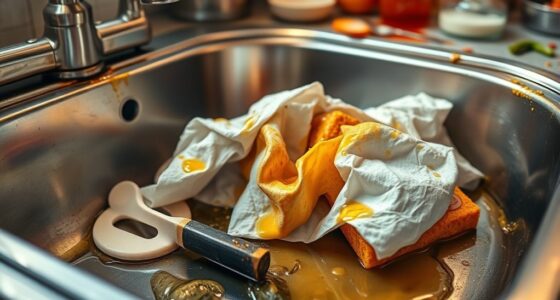To keep your summer gear in good shape for next year, start by inspecting each item for damage and cleaning thoroughly—use mild soap for tents, vacuum sleeping bags, and scrub cookware gently. Store everything in breathable containers, avoiding plastic bins that trap moisture. Hang bulky items and organize gear with labels for easy access later. Regularly check your stored gear, and if you want tips on maintaining its condition, keep exploring how to care for your equipment properly.
Key Takeaways
- Thoroughly clean and dry all gear to prevent mold, mildew, and odors before storage.
- Inspect equipment for damage or wear, repairing any issues to ensure readiness next season.
- Use breathable containers and proper storage methods to protect gear from moisture and deterioration.
- Label storage containers and organize gear in dedicated spaces for easy access and maintenance.
- Regularly check stored items during the off-season to catch potential problems early and maintain condition.

Storing camping and sports equipment properly can extend their lifespan and keep your space organized. After a busy season of adventures, it’s essential to give your gear a thorough cleaning and find the right storage solutions. This not only preserves your equipment but also makes it easier to grab everything when next summer rolls around. Start by inspecting each item carefully, looking for signs of damage or wear. Address any necessary repairs now, so your gear is in top shape when you need it again.
Proper storage and cleaning extend your outdoor gear’s life and keep your space organized.
When it comes to cleaning techniques, it’s important to be specific to each type of equipment. For tents, shake off dirt and debris, then wipe down the fabric with a mild soap solution. Make sure to dry it completely before folding it up to prevent mold or mildew. Sleeping bags benefit from gentle vacuuming and spot cleaning with a damp cloth, followed by air drying. For camping cookware, scrub off food residues with warm water and a soft brush, avoiding harsh abrasives that could damage coatings. Sports gear like bikes or helmets should be wiped down with a damp cloth, and any moving parts should be lubricated to prevent rust. Using proper storage containers that allow for air circulation can help keep your gear fresh and ready for the next adventure.
Once everything is clean, you need to think about proper storage solutions. The goal is to keep items in a way that prevents damage and maintains their usability. Store tents, sleeping bags, and clothing in breathable bags or containers to prevent mold. Avoid plastic bins that trap moisture, which can lead to mildew. Instead, opt for canvas or fabric storage bags that allow air circulation. For bulky gear like backpacks or sleeping pads, hang them up in a closet or on hooks to maintain their shape. Bikes should be stored upright or on wall mounts to avoid warping tires or frames. Helmets and smaller items can be kept in designated bins, making them easy to locate when needed.
Organizing your equipment also involves labeling storage containers and creating a dedicated space for summer gear. This makes packing up at the end of the season quicker and more efficient. Regularly checking your stored items during the off-season ensures they stay in good condition, and you can catch any issues early. Incorporating proper storage solutions and attentive cleaning techniques guarantees that your camping and sports equipment will be ready for your next adventure. Taking these small steps now saves you time, money, and frustration down the line, allowing you to enjoy your outdoor activities without worry.
Frequently Asked Questions
How Often Should I Clean My Camping Gear During the Season?
You should clean your camping gear regularly, ideally after each trip or use, to maintain its condition and prevent dirt buildup. Regular cleaning helps with seasonal maintenance, ensuring your gear stays fresh and ready for next time. Don’t wait until the end of the season; instead, incorporate cleaning frequency into your routine so your equipment remains in top shape and lasts longer, saving you time and money.
What Are the Best Methods for Drying Wet Equipment?
Imagine you’re in a medieval castle, but instead, you’re tackling wet gear! To efficiently remove moisture, use proper drying techniques like air drying in a well-ventilated space or using a fan. Avoid direct sunlight, which can damage fabrics. For quick moisture removal, consider a dehumidifier or a hairdryer on low. Be sure to turn gear periodically to ensure even drying, preventing mold and bacteria.
How Can I Prevent Mold and Mildew Growth?
To prevent mold and mildew growth, focus on moisture control. Make sure your gear is completely dry before storing it, as lingering dampness promotes mold. Use breathable storage containers or bags to allow air circulation, and consider adding silica gel packets to absorb excess moisture. Regularly check your equipment for signs of mold, and guarantee your storage area is cool, dry, and well-ventilated for effective mold prevention.
Should I Use Storage Containers or Bags for Different Gear Types?
Think of your gear as treasures waiting to shine again. Choosing storage containers over bags offers better gear protection and helps you organize efficiently. Containers keep moisture and pests out, while bags are more flexible but less protective. For space optimization, stackable containers maximize your storage area and keep everything neat. So, select sturdy containers for valuable or delicate gear, ensuring it’s ready to go when adventure calls again.
How Do I Organize My Storage Space for Quick Access?
To organize your storage space for quick access, start with vertical shelving to maximize space and keep items visible. Use labeling tips to clearly mark containers and shelves, so you can find gear easily. Place frequently used items at the front or on accessible shelves, and store seasonal or less-used gear higher up. This setup helps you locate everything fast and keeps your space tidy.
Conclusion
Now that you’ve cleaned and stored your gear, imagine the adventures waiting just around the corner. But what if you discover something’s not quite right when next season rolls in? Stay tuned—you might find hidden surprises, or maybe a forgotten item that could make your next trip unforgettable. Proper storage isn’t just about preservation; it’s the key to unblocking your future adventures. Are you ready to see what’s lurking in your gear stash?










